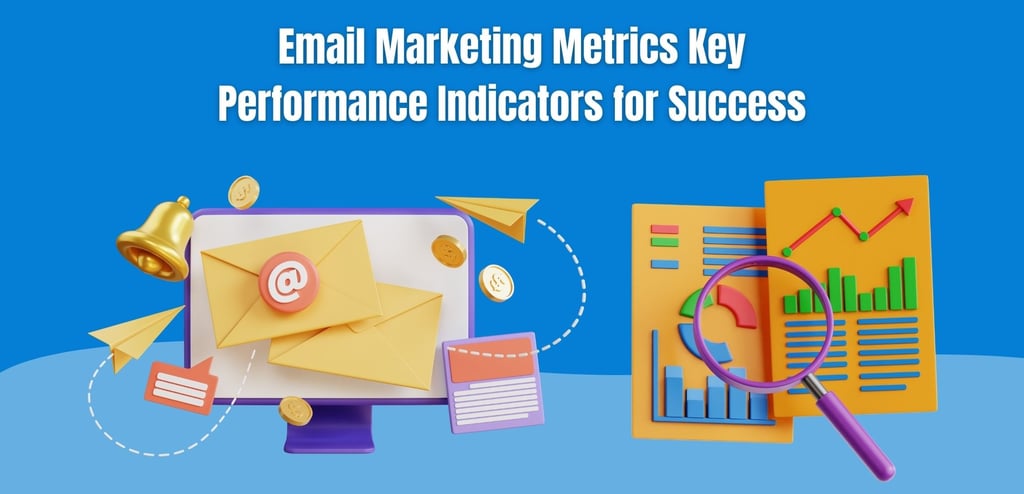
Email Marketing Metrics Key Performance Indicators for Success
By AZ Konnect Team
11/26/20246 min read


In today's digital marketing landscape, email marketing continues to be one of the most powerful tools for engaging with your audience, driving traffic, and generating sales. But to fully harness the power of email marketing, simply sending out campaigns isn’t enough—you need to measure their effectiveness. That’s where Key Performance Indicators (KPIs) come in. By tracking specific email marketing metrics, you can gain insights into what’s working, what’s not, and how to optimize future campaigns for even better results.
In this blog post, we’ll explore the most important KPIs for email marketing success, why they matter, and how you can use them to improve your campaigns.
1. Open Rate
Open rate is the percentage of recipients who open your email out of the total number of emails delivered. It is one of the most basic and essential email marketing metrics, as it indicates how compelling your subject line and email timing are.
Why It Matters:
A high open rate shows that your audience finds your emails valuable and intriguing enough to click. A low open rate, on the other hand, may suggest that your subject lines aren’t engaging, or that your emails are landing in spam folders.
How to Improve Open Rates:
Optimize Subject Lines:
Craft subject lines that are concise, personalized, and evoke curiosity. Avoid spammy phrases like "Free" or "Act Now!"
Segment Your Audience:
Sending more targeted emails based on specific customer segments can lead to better open rates.
Send at the Right Time:
Test different sending times to figure out when your audience is most likely to open your emails.
2. Click-Through Rate (CTR)
The click-through rate (CTR) measures the percentage of people who clicked on a link within your email, relative to the total number of emails delivered. CTR is crucial because it shows how effective your email content is at driving action.
Why It Matters:
CTR gives you insight into how well your message resonates with your audience. If people are clicking on your call-to-action (CTA) buttons, it’s a sign that your content is engaging and aligns with what your audience wants.
How to Improve CTR:
Use Clear and Compelling CTAs:
Your CTA should be easy to spot and encourage immediate action. Use action-oriented language like "Shop Now," "Learn More," or "Get Started."
Include Engaging Content:
Whether it’s a compelling offer, useful information, or a product showcase, make sure the content of your email aligns with your CTA.
Make Links Easy to Click:
Use buttons instead of text links for important actions. Ensure the design is mobile-friendly, so users on smartphones can click without difficulty.
3. Conversion Rate
Conversion rate measures the percentage of email recipients who completed a desired action after clicking through your email—such as making a purchase, filling out a form, or signing up for a webinar.
Why It Matters:
Conversion rate is the ultimate measure of your email campaign’s effectiveness. While a high open rate and CTR are good, conversion rate indicates whether your email marketing is actually driving business results.
How to Improve Conversion Rates:
Align Email Content with Landing Pages:
Ensure that your email content is consistent with the page recipients land on after clicking. The messaging and offer should be aligned to avoid confusion or abandonment.
Reduce Friction in the Process:
Simplify your landing page forms, optimize page load times, and minimize the number of steps users need to take to complete the action.
Offer Value:
Whether it’s a discount, a limited-time offer, or exclusive content, make sure you’re providing something that entices your audience to convert.
4. Bounce Rate
Bounce rate refers to the percentage of emails that were not delivered to recipients’ inboxes. Bounces come in two forms: soft bounces (temporary issues, like a full inbox or a problem with the recipient's server) and hard bounces (permanent issues, like an invalid email address).
Why It Matters:
A high bounce rate can affect your sender reputation and even lead to your emails being marked as spam. It also means you’re not reaching your intended audience, which undermines your campaign's overall performance.
How to Reduce Bounce Rates:
Maintain a Clean Email List:
Regularly clean your email list by removing inactive subscribers or email addresses that consistently result in hard bounces.
Use Double Opt-In:
This ensures that subscribers are entering valid email addresses, reducing the likelihood of bounces due to incorrect or fake emails.
Monitor Delivery Rates:
Work with your email service provider to ensure your emails are being delivered correctly and avoid triggering spam filters.
5. Unsubscribe Rate
The unsubscribe rate measures the percentage of recipients who opted out of your email list after receiving a campaign. While some level of unsubscribes is natural, a sudden spike can indicate a problem with your content or email frequency.
Why It Matters:
A high unsubscribe rate indicates that your emails are no longer providing value to your audience, or that you’re overwhelming them with too many messages. It’s a key metric for understanding audience satisfaction and content relevance.
How to Reduce Unsubscribe Rates:
Segment and Personalize:
Make sure you’re sending the right message to the right people. Personalization and relevant content reduce the likelihood that people will unsubscribe.
Respect Inbox Preferences:
Be mindful of how often you’re emailing your list. Too many emails can lead to fatigue and higher unsubscribe rates.
Use Engaging Content:
Always aim to provide value to your subscribers. Whether it’s educational content, exclusive offers, or helpful tips, make sure your emails are worth opening.
6. List Growth Rate
Your list growth rate tracks how quickly your email list is growing, accounting for new subscribers and unsubscribes. This KPI helps you understand whether your email acquisition strategies are effective.
Why It Matters:
A healthy list growth rate is essential for expanding your reach and keeping your email campaigns impactful. A declining list growth rate can limit your future campaign effectiveness.
How to Improve List Growth Rate:
Optimize Signup Forms:
Make it easy for people to subscribe to your email list by placing signup forms in visible locations (like your website, blog, and social media profiles). Keep forms simple and avoid asking for too much information upfront.
Offer Incentives:
Encourage new subscribers by offering a lead magnet like a discount, free eBook, or exclusive content.
Leverage Social Media:
Promote your email list on social media platforms, offering followers a reason to subscribe. For instance, highlight exclusive content or early access to sales for email subscribers only.
7. Email Sharing/Forwarding Rate
This metric measures how often recipients share your email content or forward it to others. While not as frequently discussed as open rates or CTR, the email sharing/forwarding rate is a great indicator of how valuable and shareable your content is.
Why It Matters:
If people are sharing your emails, it’s a sign that your content is resonating with them. It also helps you grow your email list and expand your brand reach organically.
How to Encourage Sharing:
Include Social Sharing Buttons:
Make it easy for readers to share your content on social media by adding social sharing buttons to your emails.
Create Share-Worthy Content:
Offer value in every email. Whether it’s insightful articles, entertaining videos, or compelling offers, give your audience a reason to share your message with their friends or colleagues.
Ask for Referrals:
Sometimes, a simple “forward to a friend” call to action can increase sharing, especially if you’re running a referral or reward program.
8. Return on Investment (ROI)
One of the most important KPIs in any marketing campaign is Return on Investment (ROI), which measures the revenue generated from your email marketing efforts relative to the cost. This metric shows you how effective your email marketing is at driving actual business results.
Why It Matters:
ROI gives you the clearest picture of your campaign’s success in terms of profitability. A high ROI means that your email campaigns are delivering substantial returns on your investment, while a low ROI may indicate that it’s time to rethink your strategy.
How to Improve ROI:
Optimize Campaigns for Conversions:
Use A/B testing to experiment with subject lines, CTAs, and email layouts to find what drives the highest conversions.
Segment Your List:
Target different segments of your email list with personalized offers and content to drive higher engagement and conversions.
Automate Your Email Workflows:
Set up automated email sequences, like welcome emails, abandoned cart reminders, and post-purchase follow-ups, to drive engagement and sales without constant manual effort.
Conclusion
Email marketing remains a key driver of business success, but its true power lies in its measurability. By tracking and optimizing key performance indicators like open rates, click-through rates, conversion rates, and ROI, you can fine-tune your campaigns and ensure that they are delivering the best possible results.
Each metric offers unique insights, and together, they provide a comprehensive view of your email marketing performance. Focus on these KPIs, make data-driven adjustments, and your email campaigns will continue to grow, engage, and convert your audience—ultimately boosting your business success.
Subscribe To Our Newsletter


